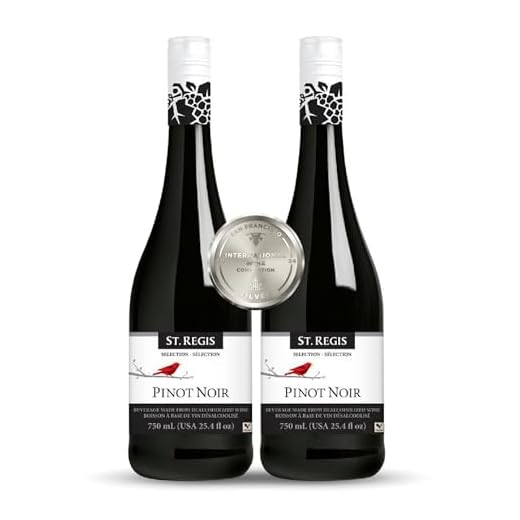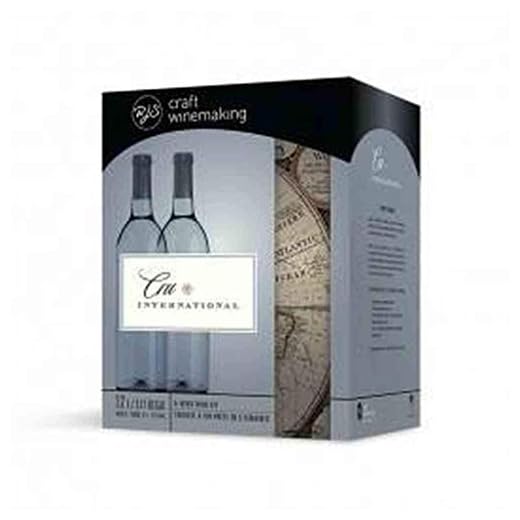



Opt for a medium to full-bodied option that showcases rich fruit flavors and good acidity. A classic choice is Pinot Noir, known for its ability to complement the dish’s earthy tones while enhancing the overall depth of flavor. Look for bottles from Burgundy or even California, where the climate allows for vibrant expression.
Avoid overly tannic selections, as they may overpower the dish. Instead, focus on wines that offer a harmonious balance of fruit, earthiness, and acidity. Merlot or Grenache can also work well, providing a softer profile that complements the savory elements without overshadowing them.
Always prioritize quality; a wine that pleases your palate can elevate the dish significantly. Remember, the aim is to create a delightful synergy between the flavors of the stew and the selected beverage. Experiment with different varietals to discover combinations that resonate with your taste preferences.
Choosing the Right Wine for Beef Bourguignon
A full-bodied red is ideal for enhancing the flavors in this classic dish. Seek out options like Pinot Noir, which is traditional for its fruity notes and acidity that complements the meat beautifully. Merlot can also be a fantastic choice, offering a softer profile that balances well with the rich sauce.
Consider the Origin
Wines from Burgundy are traditional favorites due to their regional alignment, but don’t limit yourself. A well-structured Cabernet Sauvignon may add depth and complexity, while a Syrah can introduce spicy undertones that elevate the entire meal. Always aim for a wine that has enough acidity to cut through the richness of the dish.
Quality Matters
Opt for a bottle that you would enjoy drinking on its own. The quality of the wine significantly influences the final flavor of the dish. Avoid overly sweet or low-quality options, as they can detract from the overall experience. A good rule of thumb is to choose something in the $15-$30 range for cooking, striking a balance between value and quality.
Understanding the Role of Wine in Beef Bourguignon
Opt for a full-bodied option with good acidity and tannins to enhance the flavors in the dish. A wine that can stand up to the richness of the meat will create a harmonious balance. Burgundy is often considered the classic choice due to its regional connection and flavor profile, but alternatives like Cabernet Sauvignon or Merlot can also work well if they meet the quality standards.
Look for a bottle that has some age; a wine with a few years can offer more complexity and depth, which is beneficial when simmering for hours. Avoid overly sweet or light varieties, as they won’t provide the necessary structure and depth. Instead, aim for something that complements the savory elements like mushrooms, herbs, and the rich sauce.
Keep in mind that the cooking process will alter the wine’s characteristics, making it less about the nuances and more about the foundational flavors. Therefore, the initial choice should focus on a robust profile that can withstand cooking while still contributing positively to the final dish.
Experimentation is key. Trying different varietals can lead to delightful surprises. Each choice will impart its own character to the stew, allowing for a unique culinary experience every time. Trust your palate, and let it guide you to the right selection for your next culinary creation.
Characteristics of Red Wine Suitable for Cooking
Opt for a bottle with moderate tannins and acidity. Varieties such as Merlot or Pinot Noir excel in this category, providing a balanced flavor profile that enhances dishes without overpowering them.
Consider the wine’s age. A younger vintage generally possesses fruit-forward characteristics, while older wines may offer more complex, earthy notes that can elevate the depth of a dish.
The alcohol content plays a significant role as well. A wine with an alcohol level between 12% and 14% ensures a harmonious integration into the recipe, allowing for a rich flavor without excessive sharpness.
Look for wines with bright fruit flavors, such as cherry or plum. These notes complement the savory elements of the dish, creating a delightful contrast that enhances the overall experience.
Avoid overly sweet or overly oaked selections. Excess sweetness can clash with the savory notes, while excessive oak can dominate the dish, masking the nuanced flavors.
Lastly, consider the origin. Wines from regions known for their robust blends, like Bordeaux or Burgundy, can add a unique character to your culinary creation, enriching the final outcome.
Popular Red Wines Recommended for Beef Bourguignon
For a delightful preparation of this classic dish, consider the following selections:
Burgundy Pinot Noir
This varietal from the Burgundy region offers an authentic connection to the dish’s origins. Its elegant structure and earthy undertones complement the flavors beautifully.
Cabernet Sauvignon
A bold choice, Cabernet Sauvignon brings a rich, full-bodied profile with dark fruit notes that enhance the beef’s robustness. Opt for a Napa Valley or Chilean option for excellent results.
Merlot
Known for its smoothness, Merlot provides a softer texture and fruity character, balancing the dish’s richness without overpowering it.
Syrah/Shiraz
This grape variety provides a spicier component, with smoky and peppery notes that can add depth to the overall flavor profile.
Malbec
With its dark fruit flavors and velvety tannins, Malbec offers a delightful pairing that enhances the savory elements of the dish.
Table of Recommended Wines
| Wine Type | Flavor Profile | Region |
|---|---|---|
| Burgundy Pinot Noir | Earthy, elegant | Burgundy, France |
| Cabernet Sauvignon | Bold, dark fruit | Napa Valley, USA |
| Merlot | Smooth, fruity | Various |
| Syrah/Shiraz | Spicy, smoky | Rhone Valley, France / Australia |
| Malbec | Rich, velvety | Argentina |
These selections will elevate the dish, ensuring a memorable culinary experience. Happy cooking!
How Wine Choice Affects the Flavor Profile of the Dish
Selecting the right varietal significantly alters the taste nuances in a dish. A wine’s characteristics, such as acidity, tannins, and fruit profile, directly impact the overall flavor experience. Here are key factors to consider:
Acidity
- Higher acidity wines can brighten flavors, making the dish feel lighter and more refreshing.
- Lower acidity options may result in a richer, deeper flavor, but risk overwhelming the palate.
Tannins
- Wines with robust tannins enhance the richness of the meat, creating a harmonious balance.
- Choosing a softer tannin profile may lead to a smoother, more integrated flavor, but could lack depth.
Fruitiness plays a role as well. A wine showcasing dark fruit flavors can complement the savory aspects of the dish, while a more floral or lighter fruit selection may offer contrast and complexity.
In my experience, wines like Pinot Noir or Merlot often work well, providing a balanced profile that elevates the dish’s essence. For additional culinary inspiration, check out this link on how to cook lambs liver and onions.
Tips for Selecting the Right Red Wine on a Budget
Opt for varietals like Merlot or Cabernet Sauvignon, which often provide excellent value without sacrificing flavor. Look for bottles from lesser-known regions, as they can deliver quality at a fraction of the price of famous locations.
Check for sales at local retailers or online shops; many offer discounts on specific brands or during seasonal promotions. Consider purchasing wines from grocery stores, where prices can be more competitive than specialized wine shops.
Explore options from emerging wine-producing countries such as Portugal or Chile. These regions frequently produce outstanding selections that are both affordable and flavorful.
Don’t overlook the importance of vintage. A recent year may yield delightful options, but older vintages can sometimes be found at reduced prices, especially if they haven’t garnered attention yet.
Read reviews or seek recommendations from trusted sources. Websites dedicated to wine ratings can guide you toward hidden gems that won’t break the bank.
Try wines labeled as “second wines” from prestigious producers. These often share the same grapes and techniques as their higher-priced counterparts, allowing for a taste of luxury on a budget.
Join wine clubs or subscription services that curate selections based on budget and preferences. This can lead to discovering great values while expanding your palate.
Lastly, don’t hesitate to ask for staff recommendations at wine shops. Knowledgeable employees can point you towards budget-friendly options that still meet your culinary needs.
FAQ:
Can any red wine be used for beef bourguignon, or are there specific types recommended?
While you can technically use any red wine for beef bourguignon, it is best to choose a wine that complements the dish. Wines such as Burgundy, Pinot Noir, or Merlot are commonly recommended due to their flavor profiles. These wines have the right balance of acidity and fruitiness that enhances the dish’s rich flavors. Using a quality wine will improve the overall taste of your beef bourguignon.
Does the quality of red wine matter when making beef bourguignon?
Yes, the quality of red wine does matter when making beef bourguignon. Using a wine that you enjoy drinking will likely result in a better dish. A higher-quality wine will bring out the flavors of the beef and other ingredients during the cooking process. While it doesn’t have to be an expensive bottle, a decent quality wine will elevate the dish significantly.
Can I use a sweet red wine for beef bourguignon?
Using a sweet red wine for beef bourguignon is not recommended. The sweetness can clash with the savory flavors of the dish and alter the intended taste. It’s better to stick with dry red wines that provide acidity and complexity, which are better suited for enhancing the flavors of the beef and vegetables in the stew.
Is it necessary to use French wine for beef bourguignon?
It is not strictly necessary to use French wine for beef bourguignon, although it is traditional to do so. The dish originates from the Burgundy region, where Pinot Noir is a prominent varietal. However, you can use any dry red wine that you prefer or have on hand. Just make sure it pairs well with the other ingredients and complements the overall flavor of the dish.
How does the choice of red wine affect the flavor of beef bourguignon?
The choice of red wine can significantly affect the flavor of beef bourguignon. Different wines bring various notes and aromas to the dish. A wine with fruity notes can add depth, while one with earthy undertones can enhance the umami flavors of the beef. The wine also helps to tenderize the meat during cooking, so selecting a wine that you enjoy drinking will likely result in a more flavorful and enjoyable dish.









